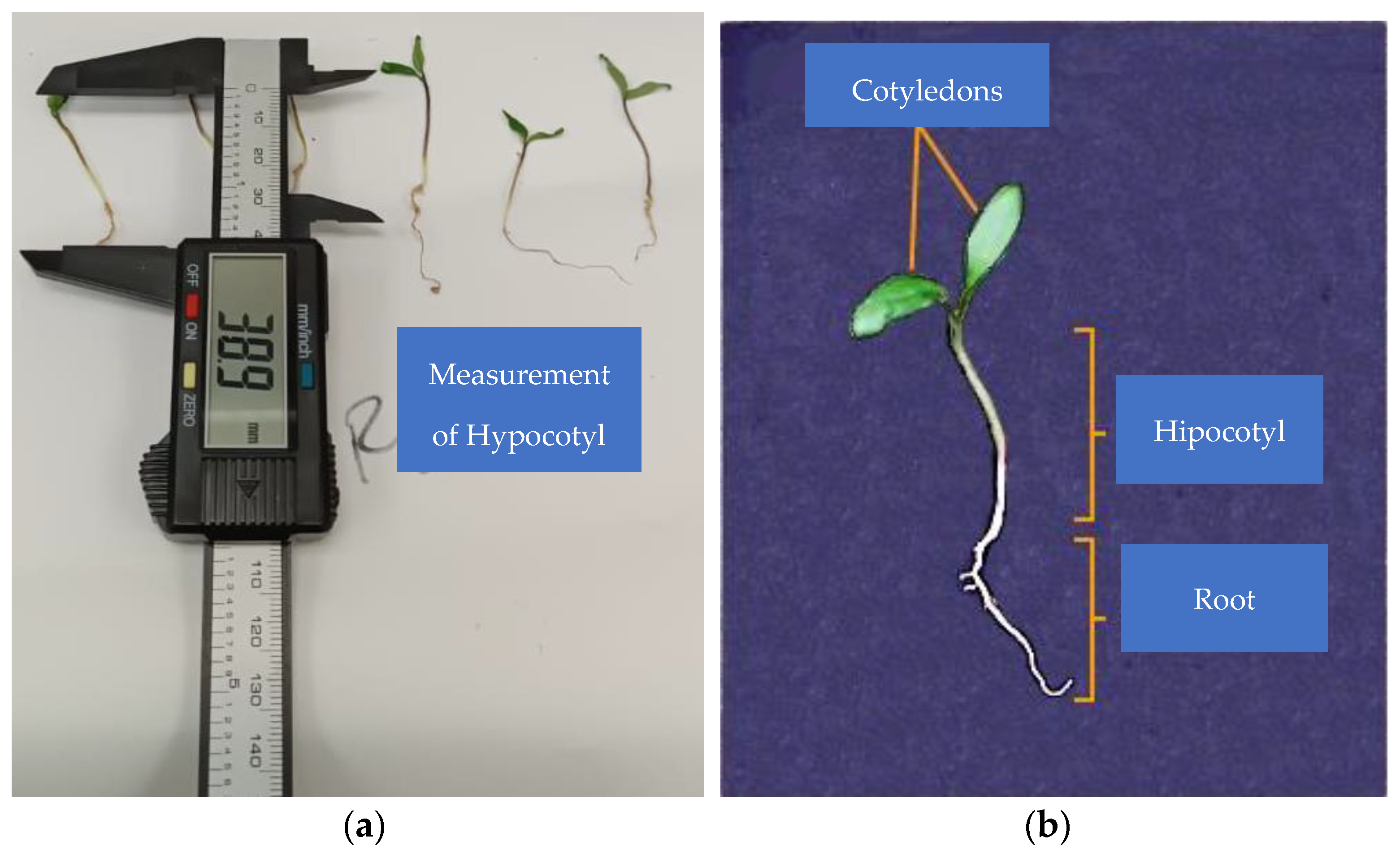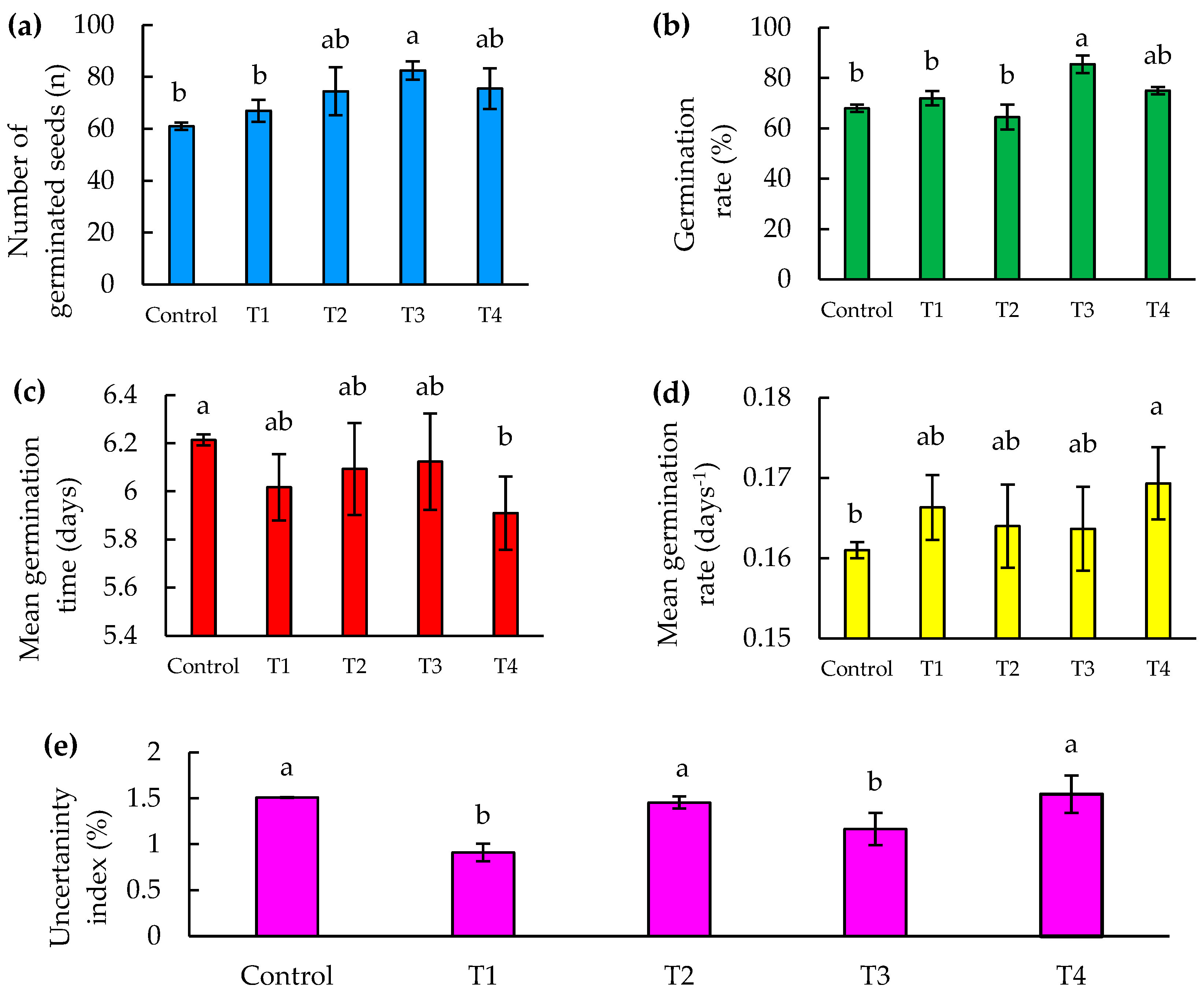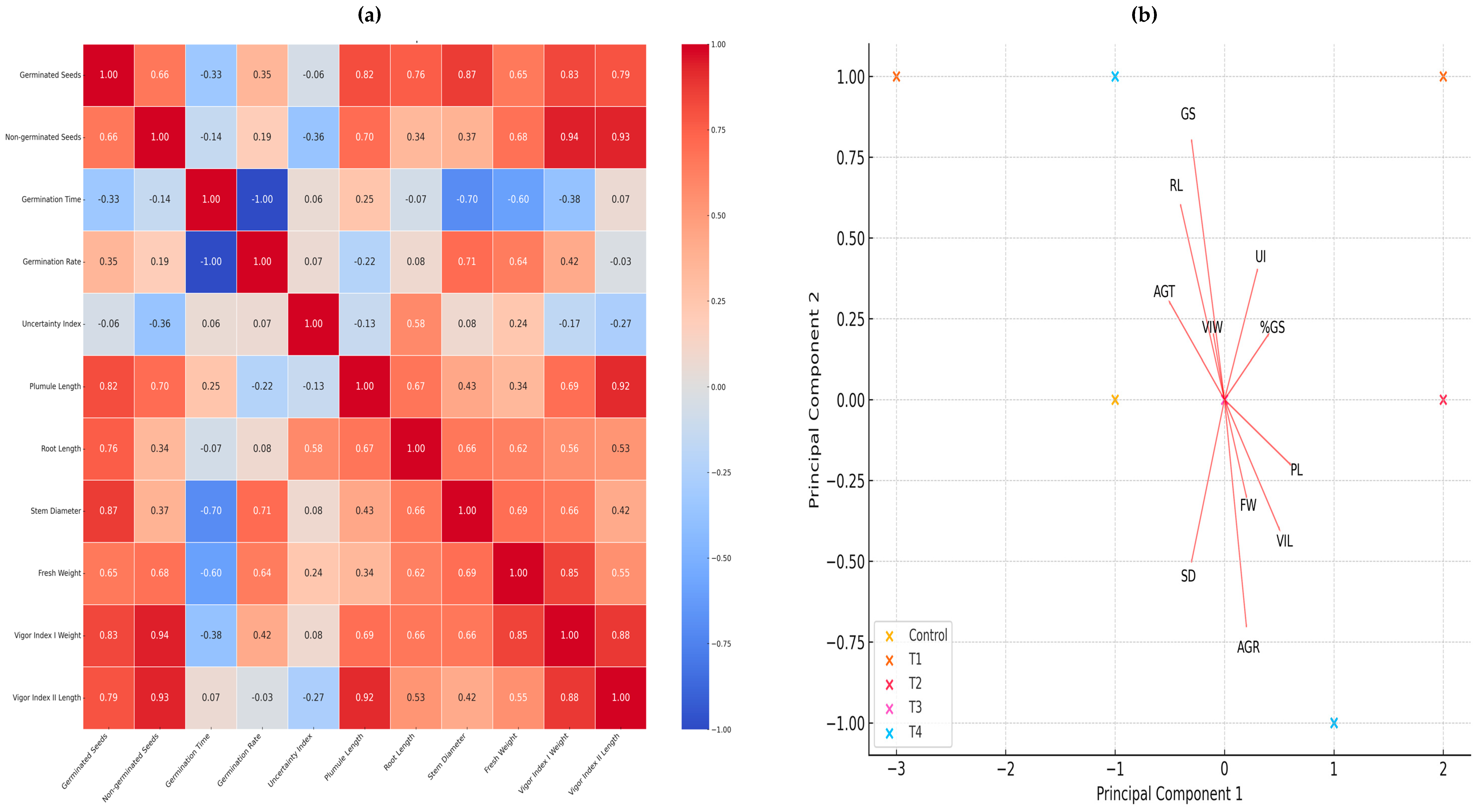Nanopriming with Zinc–Molybdenum in Jalapeño Pepper on Imbibition, Germination, and Early Growth
Abstract
1. Introduction
2. Materials and Methods
2.1. Experimental Site, Plant Material, and Nanofertilizer
2.2. Experiment 1: Seed Imbibition
2.2.1. Experimental Design and Treatments
2.2.2. Nanopriming of Seeds
2.3. Experiment 2: Germination and Early Seedling Growth
2.3.1. Experimental Design and Treatments
2.3.2. Sowing and Germination
2.3.3. Crop Management
2.3.4. Measurements of Germination Parameters, Vigor, and Morphological Indexes
- (a)
- Number of germinated seeds (ni)—the number of seeds that germinated in time k.
- (b)
- The percentage of seeds that complete the germination process, which is calculated with Equation (1).
- (c)
- The mean germination time (MGT) is calculated with Equation (2); this denotes the number of germinated seeds with respect to the number of germinated seeds at the time of evaluation.
- (d)
- The mean germination rate (MGR) is expressed as the reciprocal of MGT.
- (e)
- The uncertainty of germination (INC), an adaptation of the Shannon index, evaluates the uncertainty associated with the relative distribution of the germination frequency, where the germination frequency is calculated with Equation (3). When uncertainty values are low, the germination frequency should be higher, since this index evaluates the degree of dispersion of germination using Equation (4):
2.4. Statistical Analysis
3. Results and Discussion
3.1. Percentage of Imbibition
3.2. Imbibition Curves
3.3. Germination Parameters
3.3.1. Number of Seeds Germinated
3.3.2. Germination Percentage
3.3.3. Mean Germination Time and Mean Germination Rate
3.3.4. Uncertainty Index of Germination
3.4. Morphological and Seedling Vigor Parameters
3.5. Correlation Analysis and Heat Map
3.6. Principal Component Analysis
- Principal Component 1 (PC1) explains 54.67% of the total variation in the data.
- Principal Component 2 (PC2) explains 23.81% of the total variation in the data.
4. Conclusions
Author Contributions
Funding
Data Availability Statement
Acknowledgments
Conflicts of Interest
References
- Vasileva, K.; Todorova, V.; Masheva, S. Evaluation of collection of pepper (Capsicum spp.) resources for resistance to Verticillium dahliae Kleb. Bulg. J. Agric. Sci. 2019, 25, 1030–1038. [Google Scholar]
- Sánchez-Toledano, B.I.; Gómez, D.M.J.C.; Cuevas-Reyes, V.; Salgado-Beltrán, L. Characterization of the preferences towards jalapeño peppers from the perspective of the Sonoran consumers. Agro Product. 2021, 14, 55–61. [Google Scholar] [CrossRef]
- Sánchez-Toledano, B.I.; Cuevas-Reyes, V.; Kallas, Z.; Zegbe, J.A. Preferences in jalapeño pepper attributes: A choice study in Mexico. Foods 2021, 10, 3111. [Google Scholar] [CrossRef] [PubMed]
- García-Vásquez, R.; Vera-Guzmán, A.M.; Carrillo-Rodríguez, J.C.; Pérez-Ochoa, M.L.; Aquino-Bolaños, E.N.; Alba-Jiménez, J.E.; Chávez-Servia, J.L. Bioactive and nutritional compounds in fruits of pepper (Capsicum annuum L.) landraces conserved among indigenous communities from Mexico. AIMS Agric. Food 2023, 8, 832–850. [Google Scholar] [CrossRef]
- Sánchez Toledano, B.I.; Camarena Gómez, D.M.J.; López Santiago, M.A.; Cuevas Reyes, V. Consumer Preferences of Jalapeño Pepper in the Mexican Market. Horticulturae 2023, 9, 684. [Google Scholar] [CrossRef]
- Rodríguez-Barajas, N.; Montalvo-González, E.; Villagrán, Z.; González-Torres, S.; Villaruel-López, A.; Esparza, L.M.A. Chili and Pepper Byproducts. In Food Byprodructs, 1st ed.; Martin-Del-Campo, S.T., Cardador-Martínez, A., Ramírez-Anaya, J.D.P., Eds.; Nova Science Publishers: New York, NY, USA, 2023; Volume 1, pp. 75–96. [Google Scholar]
- Khan, H.A.; Ziaf, K.; Amjad, M.; Iqbal, Q. Exogenous application of polyamines improves germination and early seedling growth of hot pepper. Chil. J. Agric. Res. 2012, 72, 429–433. [Google Scholar] [CrossRef]
- Qin, K.; Leskovar, D.I. Humic substances improve vegetable seedling quality and post-transplant yield performance under stress conditions. Agriculture 2020, 10, 254. [Google Scholar] [CrossRef]
- Moncada, A.; Vetrano, F.; Esposito, A.; Miceli, A. Fertigation management and growth-promoting treatments affect tomato transplant production and plant growth after transplant. Agronomy 2020, 10, 1504. [Google Scholar] [CrossRef]
- Singh, A.; Sengar, R.S.; Sharma, R.; Rajput, P.; Singh, A.K. Nano-Priming Technology for Sustainable Agriculture. Biogeosyst. Tech. 2021, 8, 79–92. [Google Scholar]
- El-Maarouf-Bouteau, H. The seed and the metabolism regulation. Biology 2022, 11, 168. [Google Scholar] [CrossRef] [PubMed]
- Zhang, H.Y.; Su, W.H. Classification, uptake, translocation, and detection methods of nanoparticles in crop plants: A review. Environ. Sci. Nano 2024, 11, 1847–1870. [Google Scholar] [CrossRef]
- Yadav, N.; Bora, S.; Devi, B.; Upadhyay, C.; Singh, P. Nanoparticle-Mediated Defense Priming: A Review of Strategies for Enhancing Plant Resilience against Biotic and Abiotic Stresses. Plant Physiol. Biochem. 2024, 213, 108796. [Google Scholar] [CrossRef] [PubMed]
- Salam, A.; Afridi, M.S.; Javed, M.A.; Saleem, A.; Hafeez, A.; Khan, A.R.; Gan, Y. Nano-priming against abiotic stress: A way forward towards sustainable agriculture. Sustainability 2022, 14, 14880. [Google Scholar] [CrossRef]
- Oh, S.; Cave, G.; Lu, C. Vitamin B12 (Cobalamin) and micronutrient fortification in food crops using nanoparticle technology. Front. Plant Sci. 2021, 12, 668819. [Google Scholar] [CrossRef] [PubMed]
- do Espirito Santo Pereira, A.; Caixeta Oliveira, H.; Fernandes Fraceto, L.; Santaella, C. Nanotechnology potential in seed priming for sustainable agriculture. Nanomaterials 2021, 11, 267. [Google Scholar] [CrossRef] [PubMed]
- Magdaleno-García, G.; Juárez-Maldonado, A.; Betancourt-Galindo, R.; González-Morales, S.; Sánchez-Vega, M.; Méndez-Lopez, A. Zinc oxide nanoparticle morphology modify germination and early growth of bell pepper seedlings. Biotecnia 2023, 25, 5–15. [Google Scholar] [CrossRef]
- Itroutwar, P.D.; Kasivelu, G.; Raguraman, V.; Malaichamy, K.; Sevathapandian, S.K. Effects of biogenic zinc oxide nanoparticles on seed germination and seedling vigor of maize (Zea mays). Biocatal. Agric. Biotechnol. 2020, 29, 101778. [Google Scholar] [CrossRef]
- Shcherbakova, E.N.; Shcherbakov, A.V.; Andronov, E.E.; Gonchar, L.N.; Kalenskaya, S.M.; Chebotar, V.K. Combined pre-seed treatment with microbial inoculants and Mo nanoparticles changes composition of root exudates and rhizosphere microbiome structure of chickpea (Cicer arietinum L.) plants. Symbiosis 2017, 73, 57–69. [Google Scholar] [CrossRef]
- Nanda, J.; Dwibedi, S.K.; Samant, P.K.; Patnaik, G.P.; Paikaray, R.K.; Bal, M.; Rath, B.S. Effect of molybdenum trioxide nanoparticle-mediated seed priming on the productivity of green gram (Vigna radiata L.). Environ. Conserv. J. 2023, 24, 131–139. [Google Scholar] [CrossRef]
- Pompelli, M.F.; Jarma-Orozco, A.; Rodriguez-Páez, L.A. Imbibition and germination of seeds with economic and ecological interest: Physical and biochemical factors involved. Sustainability 2023, 15, 5394. [Google Scholar] [CrossRef]
- Sánchez, E.; Rivero, R.M.; Ruiz, J.M.; Romero, L. Changes in biomass, enzymatic activity and protein concentration in roots and leaves of green bean plants (Phaseolus vulgaris L. cv. Strike) under high NH4NO3 application rates. Sci. Hortic. 2004, 99, 237–248. [Google Scholar] [CrossRef]
- Lozano-Isla, F.; Benites-Alfaro, O.E.; Pompelli, M.F. GerminaR: An R package for germination analysis with the interactive web application GerminaQuant for R. Wiley Ecol. Res. 2019, 34, 339–346. [Google Scholar] [CrossRef]
- Woodstock, W.L. Seed imbibition: A critical period for successful germination. Seed Technol. J. 1988, 1, 1–15. [Google Scholar]
- Portuguez-García, M.P.; Rodríguez-Ruiz, A.M.; Porras-Martínez, C.; González-Lutz, M.I. Imbibition and temperature to rupture latency of Ischaemum rugosum Salisb. UCR 2020, 31, 793–802. [Google Scholar]
- da Silva Moura, M.L.; Chagas, E.A.; Smiderle, O.J.; Vilaça, R.; Chagas, P.C.; de Moura, E.A.; Farias, E.E. Biometric characterization, water absorption curve and vigor on araçá-boi seeds. Int. J. Plant Biol. 2016, 7, 6265. [Google Scholar] [CrossRef][Green Version]
- Rai-Kalal, P.; Tomar, R.S.; Jajoo, A. H2O2 signaling regulates seed germination in ZnO nanoprimed wheat (Triticum aestivum L.) seeds for improving plant performance under drought stress. Environ. Exp. Bot. 2021, 189, 10456. [Google Scholar] [CrossRef]
- Finch-Savage, W.E.; Leubner-Metzger, G. Seed dormancy and the control of germination. New Phytol. 2006, 171, 501–523. [Google Scholar] [CrossRef] [PubMed]
- Bewley, J.D.; Bradford, K.J.; Hilhorst, H.W.M.; Nonogaki, H. Germination. In Seeds; Springer: New York, NY, USA, 2013. [Google Scholar]
- Kaya, M.D.; Okçu, G.; Atak, M.; Cıkılı, Y.; Kolsarıcı, Ö. Seed treatments to overcome salt and drought stress during germination in sunflower (Helianthus annuus L.). Eur. J. Agron. 2006, 24, 291–295. [Google Scholar] [CrossRef]
- Nonogaki, H.; Bassel, G.W.; Bewley, J.D. Germination—Still a mystery. Plant Sci. 2010, 179, 574–581. [Google Scholar] [CrossRef]
- Nonogaki, H.; Chen, F.; Bradford, K.J. Mechanisms and genes involved in germination sensu stricto. Seed Development, Dormancy and Germination. Annu. Plant Rev. 2007, 27, 264–304. [Google Scholar]
- Finch-Savage, W.E.; Bassel, G.W. Seed vigour and crop establishment: Extending performance beyond adaptation. J. Exp. Bot. 2016, 67, 567–591. [Google Scholar] [CrossRef] [PubMed]
- Baskin, J.M.; Baskin, C.C. What kind of seed dormancy might palms have? Seed Sci. Res. 2014, 24, 17–22. [Google Scholar] [CrossRef]
- Del Vecchio, S.; Mattana, E.; Acosta, A.T.; Bacchetta, G. Seed germination responses to varying environmental conditions and provenances in Crucianella maritima L., a threatened coastal species. C. R. Biol. 2012, 335, 26–31. [Google Scholar] [CrossRef] [PubMed]
- Kildisheva, O.A.; Dixon, K.W.; Silveira, F.A.; Chapman, T.; Di Sacco, A.; Mondoni, A.; Cross, A.T. Dormancy and germination: Making every seed count in restoration. Restor. Ecol. 2020, 28, 256–265. [Google Scholar] [CrossRef]
- Halmer, P. Methods to improve seed performance in the field. In Handbook of Seed Physiology; CRC Press: Boca Raton, FL, USA, 2004; pp. 125–165. [Google Scholar]
- Yılmaz, T.; Yılmaz, M. Doğu Akdeniz Bölgesindeki Relikt Kizilağac (Alnus glutinosa L. Gaertn.) Popülasyonlarinin Tohum Özellikleri. Turk. J. For. Sci. 2021, 5, 150–164. [Google Scholar] [CrossRef]
- Farooq, S.; Onen, H.; Tad, S.; Ozaslan, C.; Mahmoud, S.F.; Brestic, M.; El-Shehawi, A.M. The influence of environmental factors on seed germination of Polygonum perfoliatum L.: Implications for management. Agronomy 2021, 11, 1123. [Google Scholar] [CrossRef]
- Falleri, E. Dormancy breaking in Cornus sanguinea seeds. Seed Sci. Technol. 2004, 32, 1–4. [Google Scholar] [CrossRef]
- Hayashi, E.; Amagai, Y.; Maruo, T.; Kozai, T. Phenotypic analysis of germination time of individual seeds affected by microenvironment and management factors for cohort research in plant factory. Agronomy 2020, 10, 1680. [Google Scholar] [CrossRef]
- Tonmitr, N.; Higa, A.; Yonesu, A. Effect of LF-microwave hybrid plasma treatment on radish seed germination and sprout growth. Jpn. J. Appl. Phys. 2022, 62, SA1011. [Google Scholar] [CrossRef]
- Song, Y.; Zhao, W.; Su, Z.; Guo, S.; Du, Y.; Song, X.; Shi, X.; Li, X.; Liu, Y.; Liu, Z. Effect of Pulsed Electric Field Treatment on Seed Germination and Seedling Growth of Scutellaria baicalensis. Agriculture 2024, 14, 158. [Google Scholar] [CrossRef]
- Adhikary, S.; Biswas, B.; Chakraborty, D.; Timsina, J.; Pal, S.; Chandra-Tarafdar, J.; Banerjee, S.; Hossain, A.; Roy, S. Seed priming with selenium and zinc nanoparticles modifies germination, growth, and yield of direct-seeded rice (Oryza sativa L.). Sci. Rep. 2022, 12, 7103. [Google Scholar] [CrossRef] [PubMed]
- Mishra, D.; Chitara, M.; Negi, S.; Singh, J.; Kumar, R.; Chaturvedi, P. Biosynthesis of Zinc Oxide Nanoparticles via Leaf Extracts of Catharanthus roseus (L.) G. Don and Their Application in Improving Seed Germination Potential and Seedling Vigor of Eleusine coracana (L.) Gaertn. Adv. Agric. 2023, 2023, 7412714. [Google Scholar] [CrossRef]
- Soltani, E.; Baskin, C.C.; Gonzalez-Andujar, J.L. An overview of environmental cues that affect germination of nondormant seeds. Seeds 2022, 1, 146–151. [Google Scholar] [CrossRef]






| Treatments | Plumule Length (mm) | Root Length (mm) | Stem Diameter (mm) | Fresh Weight (mg) | Vigor Index I (Weight) | Vigor Index II (Length) |
|---|---|---|---|---|---|---|
| T0 (Control) | 28.9 ± 5.2 | 33.0 ± 4.8 | 0.26 ± 0.11 | 20.9 ± 2.6 | 18.43 ± 1.8 | 19.64 ± 3.5 |
| T1 (0–0) mg L−1 | 28.5 ± 2.3 | 30.6 ± 8.9 | 0.43 ± 0.12 *** | 21.2 ± 5.6 | 20.98 ± 4.1 | 20.51 ± 1.6 |
| T2 (62–5) mg L−1 | 31.4 ± 4.8 | 35.3 ± 9.1 | 0.55 ± 0.07 *** | 20.9 ± 3.5 | 19.46 ± 2.2 | 20.26 ± 3.1 |
| T3 (124–10) mg L−1 | 36.1 ± 2.7 * | 35.9 ± 6.9 | 0.55 ± 0.13 *** | 28.9 ± 3.1 * | 28.31 ± 2.6 *** | 30.9 ± 2.3 *** |
| T4 (248–20) mg L−1 | 29.5 ± 2.8 | 35.5 ± 5.6 | 0.63 ± 0.09 *** | 33.1 ± 2.7 * | 25.42 ± 2.1 *** | 22.11 ± 2.1 |
Disclaimer/Publisher’s Note: The statements, opinions and data contained in all publications are solely those of the individual author(s) and contributor(s) and not of MDPI and/or the editor(s). MDPI and/or the editor(s) disclaim responsibility for any injury to people or property resulting from any ideas, methods, instructions or products referred to in the content. |
© 2024 by the authors. Licensee MDPI, Basel, Switzerland. This article is an open access article distributed under the terms and conditions of the Creative Commons Attribution (CC BY) license (https://creativecommons.org/licenses/by/4.0/).
Share and Cite
Ochoa-Chaparro, E.H.; Ramírez-Estrada, C.A.; Anchondo-Páez, J.C.; Sánchez, E.; Pérez-Álvarez, S.; Castruita-Esparza, L.U.; Muñoz-Márquez, E.; Chávez-Mendoza, C.; Patiño-Cruz, J.J.; Franco-Lagos, C.L. Nanopriming with Zinc–Molybdenum in Jalapeño Pepper on Imbibition, Germination, and Early Growth. Agronomy 2024, 14, 1609. https://doi.org/10.3390/agronomy14081609
Ochoa-Chaparro EH, Ramírez-Estrada CA, Anchondo-Páez JC, Sánchez E, Pérez-Álvarez S, Castruita-Esparza LU, Muñoz-Márquez E, Chávez-Mendoza C, Patiño-Cruz JJ, Franco-Lagos CL. Nanopriming with Zinc–Molybdenum in Jalapeño Pepper on Imbibition, Germination, and Early Growth. Agronomy. 2024; 14(8):1609. https://doi.org/10.3390/agronomy14081609
Chicago/Turabian StyleOchoa-Chaparro, Erick H., Carlos A. Ramírez-Estrada, Julio C. Anchondo-Páez, Esteban Sánchez, Sandra Pérez-Álvarez, Luis U. Castruita-Esparza, Ezequiel Muñoz-Márquez, Celia Chávez-Mendoza, Juan J. Patiño-Cruz, and Cristina L. Franco-Lagos. 2024. "Nanopriming with Zinc–Molybdenum in Jalapeño Pepper on Imbibition, Germination, and Early Growth" Agronomy 14, no. 8: 1609. https://doi.org/10.3390/agronomy14081609
APA StyleOchoa-Chaparro, E. H., Ramírez-Estrada, C. A., Anchondo-Páez, J. C., Sánchez, E., Pérez-Álvarez, S., Castruita-Esparza, L. U., Muñoz-Márquez, E., Chávez-Mendoza, C., Patiño-Cruz, J. J., & Franco-Lagos, C. L. (2024). Nanopriming with Zinc–Molybdenum in Jalapeño Pepper on Imbibition, Germination, and Early Growth. Agronomy, 14(8), 1609. https://doi.org/10.3390/agronomy14081609









